Estimating the Soil Hydraulic Functions of Some Olive Orchards: Soil Management Implications for Water Saving in Soils of Salento Peninsula (Southern Italy)
Abstract
1. Introduction
2. Materials and Methods
2.1. Field Sites
2.2. Field and Lab Measurements
2.3. Capacitive-Based Soil Indicators Determination
- AC < 0.10 poor, 0.10 ≤ AC ≤ 0.14 good, 0.14 < AC ≤ 0.26 optimal, AC > 0.26 poor;
- PAWC < 0.10 poor, 0.10 ≤ PAWC < 0.15 limited, 0.15 ≤ PAWC < 0.20 good, PAWC ≥ 0.20 ideal;
- RFC < 0.6 poor (water-limited soil), 0.6 ≤ RFC ≤0.7 optimal, RFC > 0.7 poor (aeration limited soil).
2.4. Data Analysis
- soil texture, which measured coarse soils (sandy-loam, loamy-sand, and sand), medium soils (sandy-clay loam, loam, silt-loam, and silt), and fine-textured soils (all the remaining classes of the USDA classification);
- soil bulk density (g cm−3), which measured BD < 1.2, 1.2 ≤ BD ≤ 1.4, and BD > 1.4;
- soil capillarity (mm), which measured 10 < λc < 42 (weak), 42 ≤ λc < 250 (moderate), and 250 ≤ λc < 1000 (strong).
3. Results
3.1. Field Sites
3.2. Evaluation of BEST for Soil Properties Classes
3.3. Impact of Soil Tillage on Physical and Hydraulic Properties of the Soil
4. Discussion
5. Conclusions
Author Contributions
Acknowledgments
Conflicts of Interest
References
- Ventrella, D.; Charfeddine, M.; Giglio, L.; Castellini, M. Application of DSSAT models for an agronomic adaptation strategy under climate change in Southern Italy: Optimum sowing and transplanting time for winter durum wheat and tomato. Ital. J. Agron. 2012, 7, 109–115. [Google Scholar] [CrossRef]
- Ventrella, D.; Giglio, L.; Charfeddine, M.; Lopez, R.; Castellini, M.; Sollitto, D.; Castrignanò, A.; Fornaro, F. Climate change impact on crop rotations of winter durum wheat and tomato in southern Italy: yield analysis and soil fertility. Ital. J. Agron. 2012, 7, 100–108 e15. [Google Scholar] [CrossRef]
- Tanasijevic, L.; Todorovic, M.; Pereira, L.S.; Pizzigalli, C.; Lionello, P. Impacts of climate change on olive crop evapotranspiration and irrigation requirements in the Mediterranean region. Agri. Water Manag. 2014, 144, 54–68. [Google Scholar] [CrossRef]
- Manici, L.M.; Castellini, M.; Caputo, F. Soil-inhabiting fungi can integrate soil physical indicators in multivariate analysis of Mediterranean agroecosystem dominated by old olive groves. Ecol. Indic. 2019, 106, 105490. [Google Scholar] [CrossRef]
- Busari, M.A.; Kukai, S.S.; Kaur, A.; Bhatt, R.; Dulazi, A.A. Conservation tillage impacts on soil, crop and the environment. Int. Soil Water Conserv. Res. 2015, 3, 119–129. [Google Scholar] [CrossRef]
- Cameira, M.R.; Fernando, R.M.; Pereira, L.S. Soil macropore dynamics affected by tillage and irrigation for a silty loam alluvial soil in southern Portugal. Soil Till. Res. 2003, 70, 131–140. [Google Scholar] [CrossRef]
- Strudley, M.W.; Green, T.R.; Ascough, J.C., II. Tillage effects on soil hydraulic properties in space and time: State of the science. Soil Till. Res. 2008, 99, 4–48. [Google Scholar] [CrossRef]
- Castellini, M.; Ventrella, D. Impact of conventional and minimum tillage on soil hydraulic conductivity in typical cropping system in southern Italy. Soil Till. Res. 2012, 124, 47–56. [Google Scholar] [CrossRef]
- Xiloyannis, C.; Martinez Raya, A.; Kosmas, C.; Favia, M. Semi-intensive olive orchards on sloping land: requiring good land husbandry for future development. J. Environ. Manag. 2008, 89, 110–119. [Google Scholar] [CrossRef]
- Palese, A.M.; Vignozzi, N.; Celano, G.; Agnelli, A.E.; Pagliai, M.; Xiloyannis, C. Influence of soil management on soil physical characteristics and water storage in a mature rainfed olive orchard. Soil Till. Res. 2014, 144, 96–109. [Google Scholar] [CrossRef]
- Gucci, R.; Caruso, G.; Bertolla, C.; Urbani, S.; Taticchi, A.; Esposto, S.; Servili, M.; Sifola, M.I.; Pellegrini, S.; Pagliai, M.; et al. Changes of soil properties and tree performance induced by soil management in a high-density olive orchard. Eur. J. Agron. 2012, 41, 18–27. [Google Scholar] [CrossRef]
- Vignozzi, N.; Agnelli, A.E.; Brandi, G.; Gagnarli, E.; Goggioli, D.; Lagomarsino, A.; Caruso, G. Soil ecosystem functions in a high-density olive orchard managed by different soil conservation practices. Appl. Soil Ecol. 2019, 134, 64–76. [Google Scholar] [CrossRef]
- Castellini, M.; Pirastru, M.; Niedda, M.; Ventrella, D. Comparing physical quality of tilled and no-tilled soils in an almond orchard in southern Italy. Ital. J. Agron. 2013, 8, 149–157. [Google Scholar] [CrossRef]
- Castellini, M.; Iovino, M. Pedotransfer functions for estimating soil water retention curve of Sicilian soils. Arch. Agron. Soil Sci. 2019, 65, 1401–1416. [Google Scholar] [CrossRef]
- Castellini, M.; Stellacci, A.M.; Tomaiuolo, M.; Barca, E. Spatial Variability of Soil Physical and Hydraulic Properties in a Durum Wheat Field: An Assessment by the BEST-Procedure. Water 2019, 11, 1434. [Google Scholar] [CrossRef]
- Lassabatère, L.; Angulo-Jaramillo, R.; Ugalde, J.M.S.; Cuenca, R.; Braud, I.; Haverkamp, R. Beerkan estimation of soil transfer parameters through infiltration experiments: BEST. Soil Sci. Soc. Am. J. 2006, 70, 521–532. [Google Scholar] [CrossRef]
- Haverkamp, R.; Ross, P.J.; Smettem, K.R.J.; Parlange, J.Y. Three-dimensional analysis of infiltration from the disc infiltrometer: 2. Physically based infiltration equation. Water Resour. Res. 1994, 30, 2931–2935. [Google Scholar] [CrossRef]
- Van Genuchten, M.T. A closed-form equation for predicting the hydraulic conductivity of unsaturated soils. Soil Sci. Soc. Am. J. 1980, 44, 892–898. [Google Scholar] [CrossRef]
- Burdine, N.T. Relative permeability calculation from pore size distribution data. Petr. Trans. Am. Inst. Min. Metall. Eng. 1953, 198, 71–77. [Google Scholar] [CrossRef]
- Brooks, R.H.; Corey, T. Hydraulic properties of porous media. In Hydrology Papers 3; Colorado State University: Fort Collins, CO, USA, 1964; p. 27. [Google Scholar]
- Castellini, M.; Di Prima, S.; Iovino, M. An assessment of the BEST procedure to estimate the soil water retention curve: A comparison with the evaporation method. Geoderma 2018, 320, 82–94. [Google Scholar] [CrossRef]
- Bagarello, V.; Di Prima, S.; Iovino, M. Comparing Alternative Algorithms to Analyze the Beerkan Infiltration Experiment. Soil Sci. Soc. Am. J. 2014, 78, 724–736. [Google Scholar] [CrossRef]
- Di Prima, S. Automatic analysis of multiple Beerkan infiltration experiments for soil Hydraulic Characterization. In Proceedings of the 1st CIGR Inter-Regional Conference on Land and Water Challenges, Bari, Italy, 10–14 September 2013; p. 127. [Google Scholar]
- Di Prima, S. Automated single ring infiltrometer with a low-cost microcontroller circuit. Comput. Electron. Agr. 2015, 118, 390–395. [Google Scholar] [CrossRef]
- Lassabatère, L.; Di Prima, S.; Angulo-Jaramillo, R.; Keesstra, S.; Salesa, D. Beerkan multi-runs for characterizing water infiltration and spatial variability of soil hydraulic properties across scales. Hydrolog. Sci. J. 2019, 64, 165–178. [Google Scholar] [CrossRef]
- Yang, J.; Xu, X.; Liu, M.; Xu, C.; Luo, W.; Song, T.; Du, H.; Kiely, G. Effects of Napier grass management on soil hydrologic functions in a karst landscape, southwestern China. Soil Till. Res. 2016, 157, 83–92. [Google Scholar] [CrossRef]
- Yang, J.; Xu, X.; Liu, M.; Xu, C.; Zhang, Y.; Luo, W.; Zhang, R.; Li, Z.; Kiely, G. Effects of Grain for Green program on soil hydrologic functions in karst landscapes, southwestern China. Agric. Ecosyst. Environ. 2017, 247, 120–129. [Google Scholar] [CrossRef]
- Khaledian, M.R.; Shabanpour, M.; Alinia, H. Saturated hydraulic conductivity variation in a small garden under drip irrigation. Geosystem Engineering 2016, 19, 266–274. [Google Scholar] [CrossRef]
- Di Prima, S.; Rodrigo-Comino, J.; Novara, A.; Iovino, M.; Pirastru, M.; Keesstra, S.; Cerda, A. Soil physical quality of citrus orchards under tillage, herbicide, and organic managements. Pedosphere 2018, 28, 463–477. [Google Scholar] [CrossRef]
- Gee, G.W.; Bauder, J. Particle-size Analysis. In Methods of Soil Analysis, Part 1, 2nd ed.; American Society of Agronomy/Soil Science Society of America: Madison, WI, USA, 1986. [Google Scholar]
- Castellini, M.; Fornaro, F.; Garofalo, P.; Giglio, L.; Rinaldi, M.; Ventrella, D.; Vitti, C.; Vonella, A.V. Effects of no-tillage and conventional tillage on physical and hydraulic properties of fine textured soils under winter wheat. Water 2019, 11, 484. [Google Scholar] [CrossRef]
- Di Prima, S.; Lassabatere, L.; Bagarello, V.; Iovino, M.; Angulo-Jaramillo, R. Testing a new automated single ring infiltrometer for Beerkan infiltration experiments. Geoderma 2016, 262, 20–34. [Google Scholar] [CrossRef]
- Reynolds, W.D.; Bowman, B.T.; Drury, C.F.; Tan, C.S.; Lu, X. Indicators of good soil physical quality: density and storage parameters. Geoderma 2002, 110, 131–146. [Google Scholar] [CrossRef]
- Ferrara, R.M.; Mazza, G.; Muschitiello, C.; Castellini, M.; Stellacci, A.M.; Navarro, A.; Lagomarsino, A.; Vitti, C.; Rossi, R.; Rana, G. Short-term effects of conversion to no-tillage on respiration and chemical-physical properties of the soil: A case study in a wheat cropping system in semi-dry environment. Ital. J. Agrometeorol. 2017, 1, 47–58. [Google Scholar] [CrossRef]
- Reynolds, W.D.; Drury, C.F.; Tan, C.S.; Fox, C.A.; Yang, X.M. Use of indicators and pore volume-function characteristics to quantify soil physical quality. Geoderma 2009, 152, 252–263. [Google Scholar] [CrossRef]
- Castellini, M.; Stellacci, A.M.; Barca, E.; Iovino, M. Application of multivariate analysis techniques for selecting soil physical quality indicators: A case study in long-term field experiments in Apulia (southern Italy). Soil Sci. Soc. Am. J. 2019, 83, 707–720. [Google Scholar] [CrossRef]
- Di Prima, S.; Castellini, M.; Abou Najm, M.R.; Stewart, R.D.; Angulo-Jaramillo, R.; Winiarski, T.; Lassabatere, L. Experimental assessment of a new comprehensive model for single ring infiltration data. J. Hydrol. 2019, 573, 937–951. [Google Scholar] [CrossRef]
- Elrick, D.E.; Reynolds, W.D. Methods for analyzing constant-head well permeameter data. Soil Sci. Soc. Am. J. 1992, 56, 320. [Google Scholar] [CrossRef]
- Reynolds, W.D.; Lewis, J.K. A drive point application of the Guelph Permeameter method for coarse-textured soils. Geoderma 2012, 187–188, 59–66. [Google Scholar] [CrossRef]
- Di Prima, S.; Stewart, R.D.; Castellini, M.; Bagarello, V.; Abou Najm, M.R.; Pirastru, M.; Giadrossich, F.; Iovino, M.; Angulo-Jaramillo, R.; Lassabatere, L. Estimating the macroscopic capillary length from Beerkan infiltration experiments. J. Hydrol. Submitted.
- Bagarello, V.; Castellini, M.; Iovino, M.; Sgroi, A. Testing the concentric-disk tension infiltrometer for field measurements of soil hydraulic conductivity. Geoderma 2010, 158, 427–435. [Google Scholar] [CrossRef]
- Rallo, G.; Provenzano, G.; Castellini, M.; Sirera, À.P. Application of EMI and FDR Sensors to assess the fraction of transpirable soil water over an olive grove. Water 2018, 10, 168. [Google Scholar] [CrossRef]
- Guzmán, G.; Perea-Moreno, A.-J.; Gómez, J.A.; Cabrerizo-Morales, M.Á.; Martínez, G.; Giráldez, J.V. Water Related Properties to Assess Soil Quality in Two Olive Orchards of South Spain under Different Management Strategies. Water 2019, 11, 367. [Google Scholar] [CrossRef]
- Rallo, G.; Agnese, C.; Minacapilli, M.; Provenzano, G. Assessing AQUACROP water stress function to evaluate the transpiration reductions of olive mature tree. Ital. J. Agrometeorol. 2012, 1, 21–28. [Google Scholar]
- Autovino, D.; Rallo, G.; Provenzano, G. Predicting soil and plant water status dynamic in olive orchards under different irrigation systems with Hydrus-2D: Model performance and scenario analysis. Agric. Water Manag. 2018, 203, 225–235. [Google Scholar] [CrossRef]
- Cornara, D.; Saponari, M.; Zeilinger, A.R.; de Stradis, A.; Boscia, D.; Loconsole, G.; Bosco, D.; Martelli, G.P.; Almeida, R.P.P.; Porcelli, F. Spittlebugs as vectors of Xylella fastidiosa in olive orchards in Italy. J. Pest Sci. 2017, 90, 521. [Google Scholar] [CrossRef] [PubMed]
- Milgroom, J.; Soriano, M.A.; Garrido, J.M.; Gómez, J.A.; Fereres, E. The influence of a shift from conventional to organic olive farming on soil management and erosion risk in southern Spain. Renew. Agric. Food Syst. 2007, 22, 1–10. [Google Scholar] [CrossRef]
- Rodrigo-Comino, J.; Taguas, E.; Seeger, M.; Ries, J.B. Quantification of soil and water losses in an extensive olive orchard catchment in Southern Spain. J. Hydrol. 2018, 556, 749–758. [Google Scholar] [CrossRef]
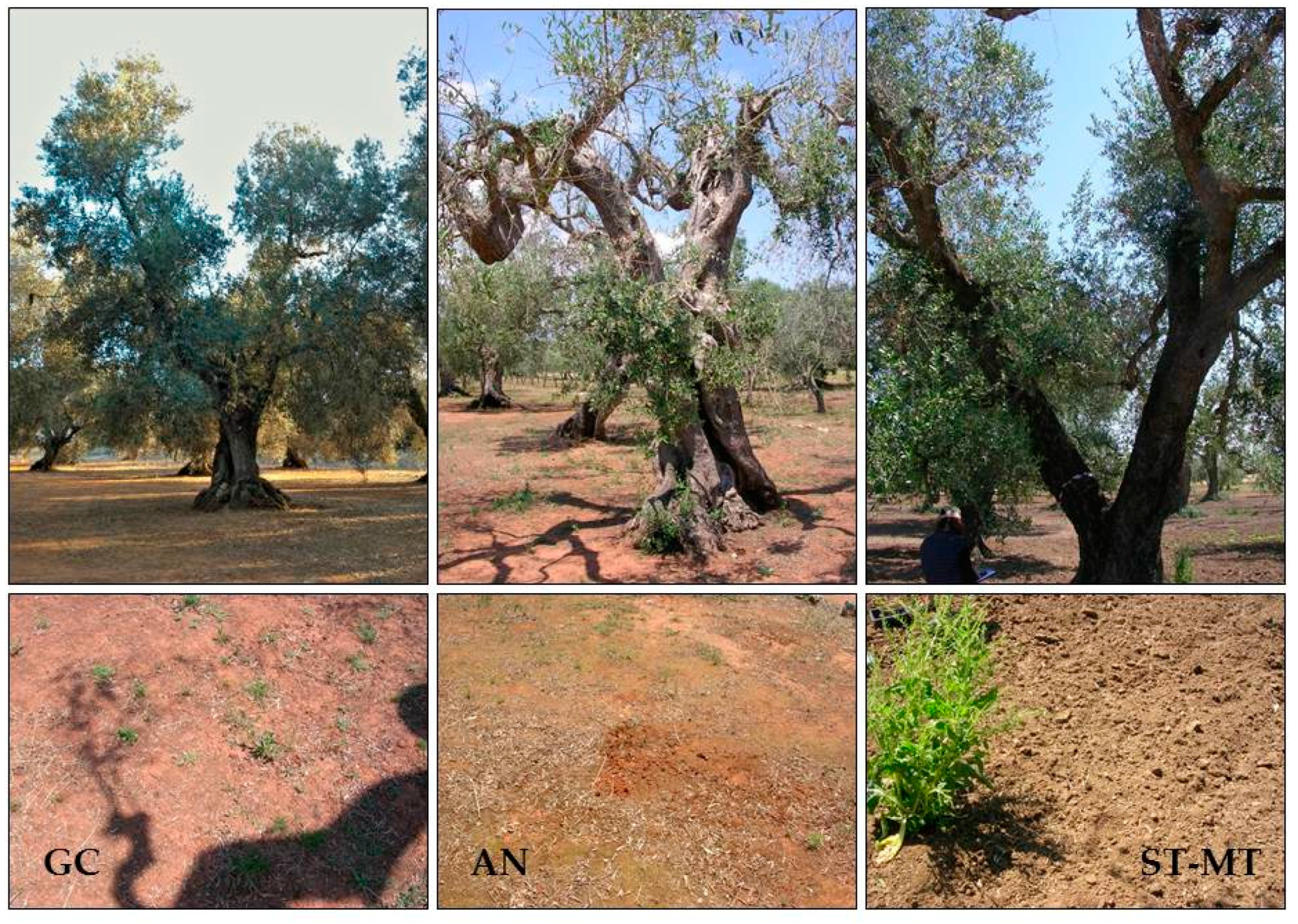
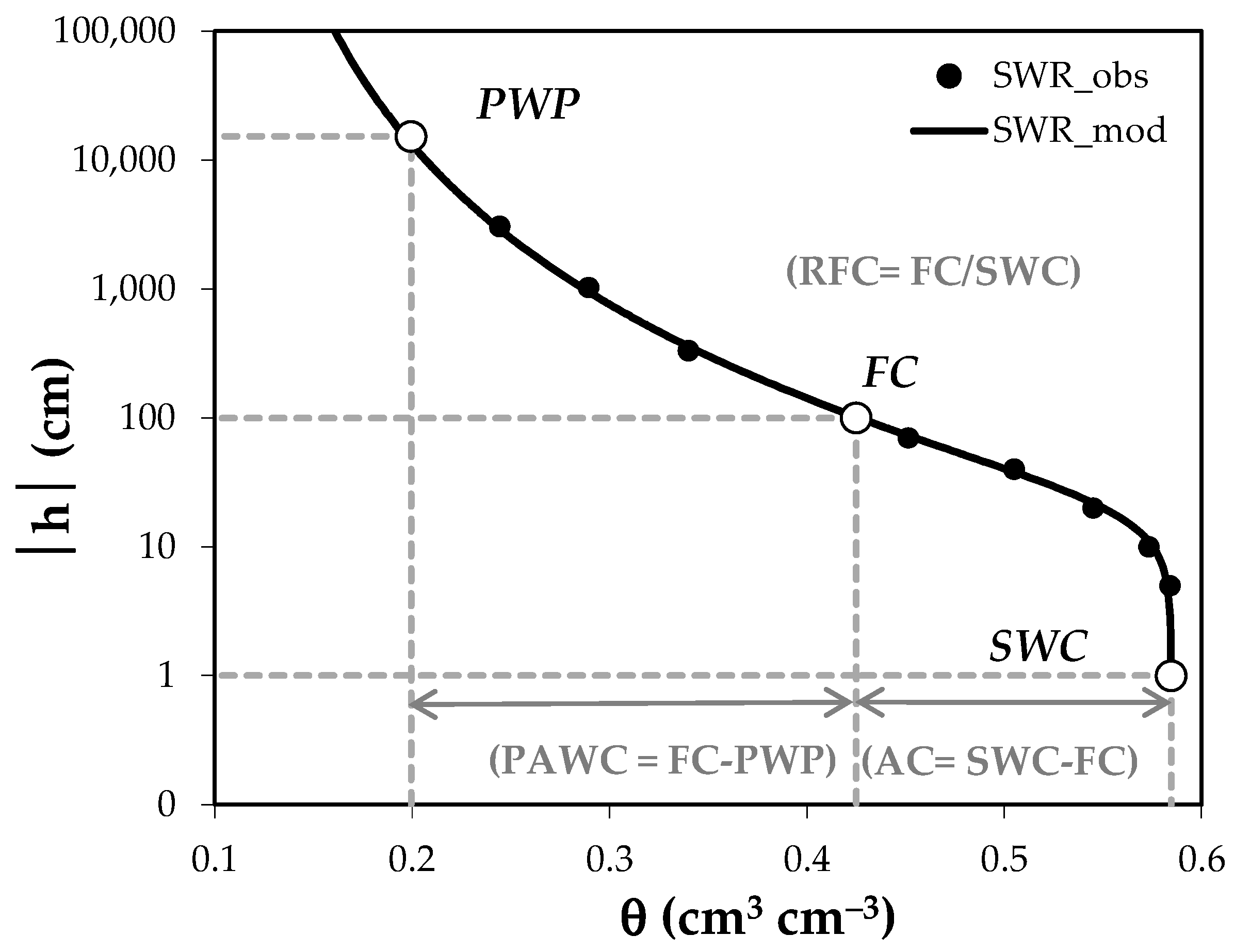
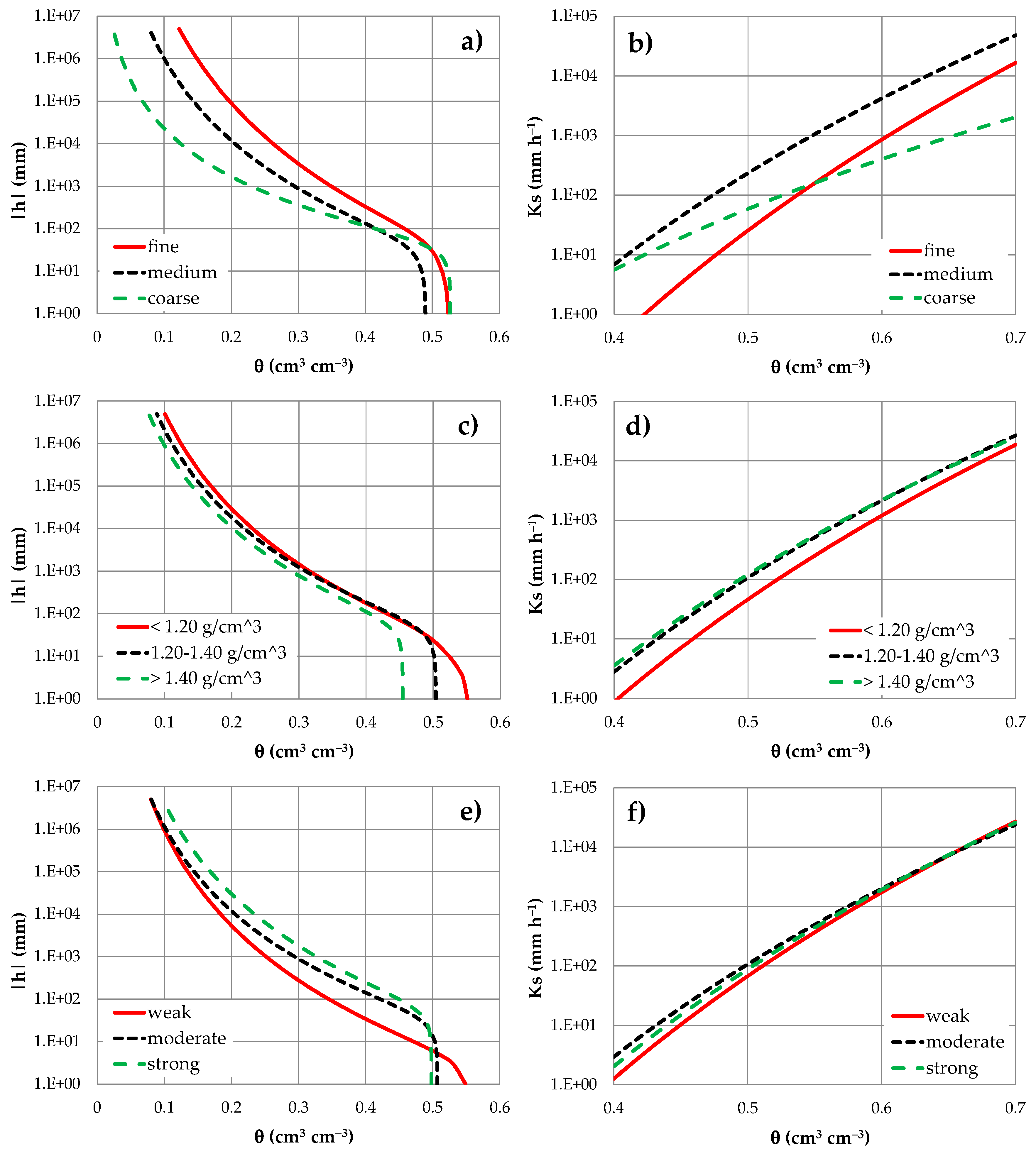
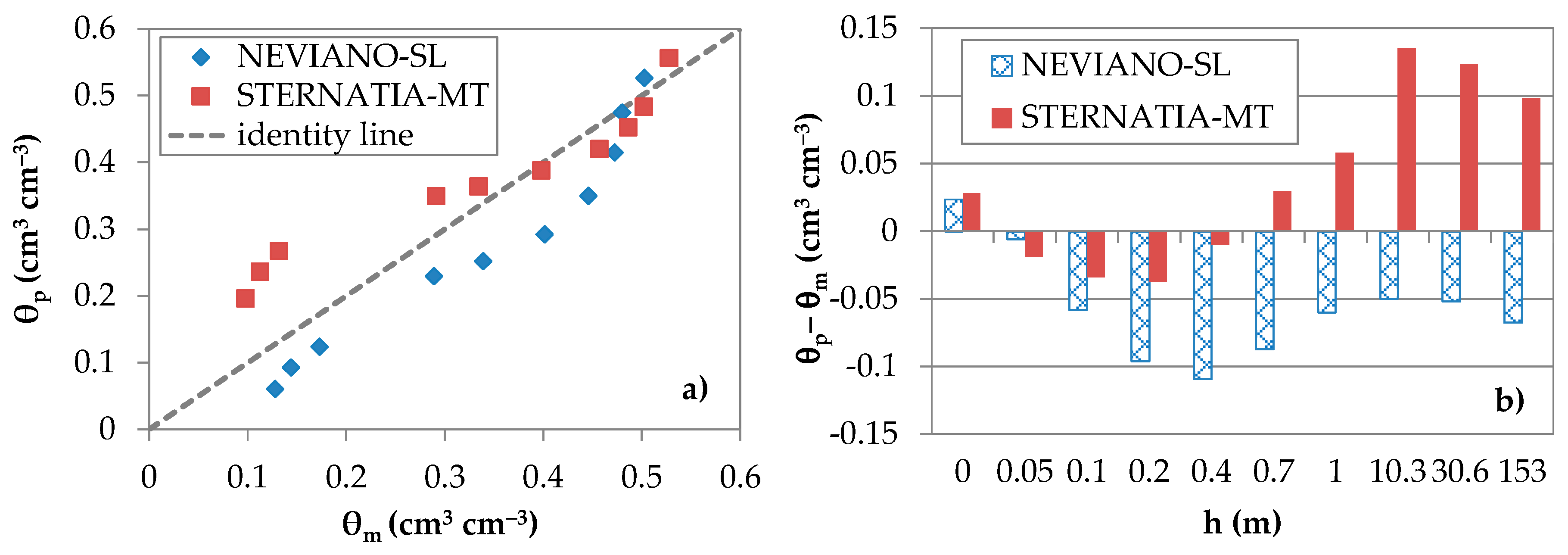
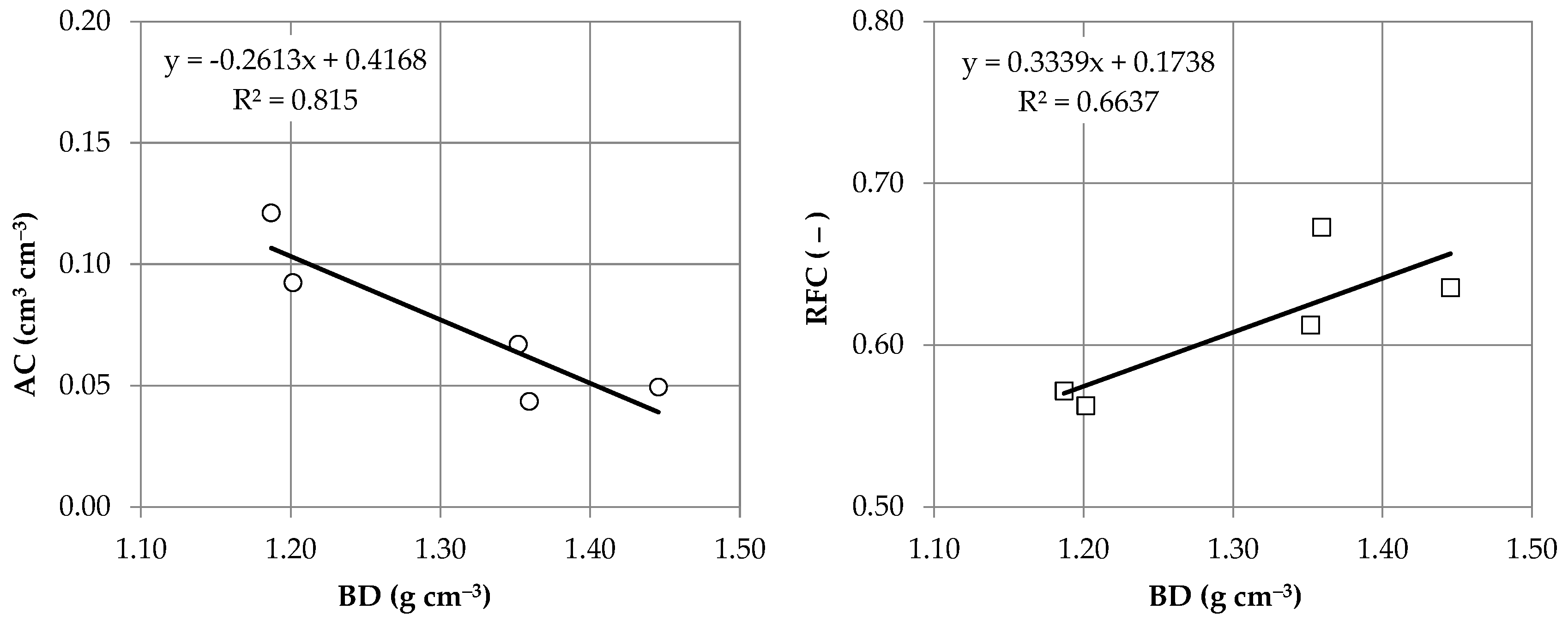
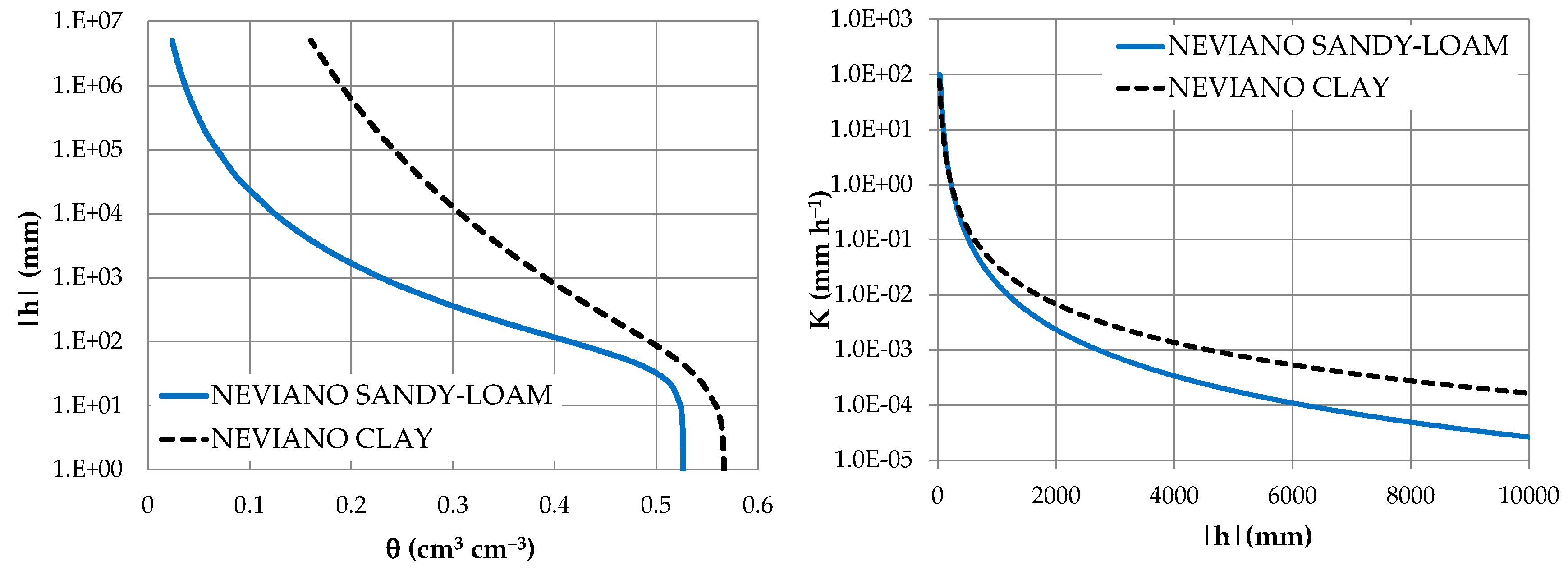
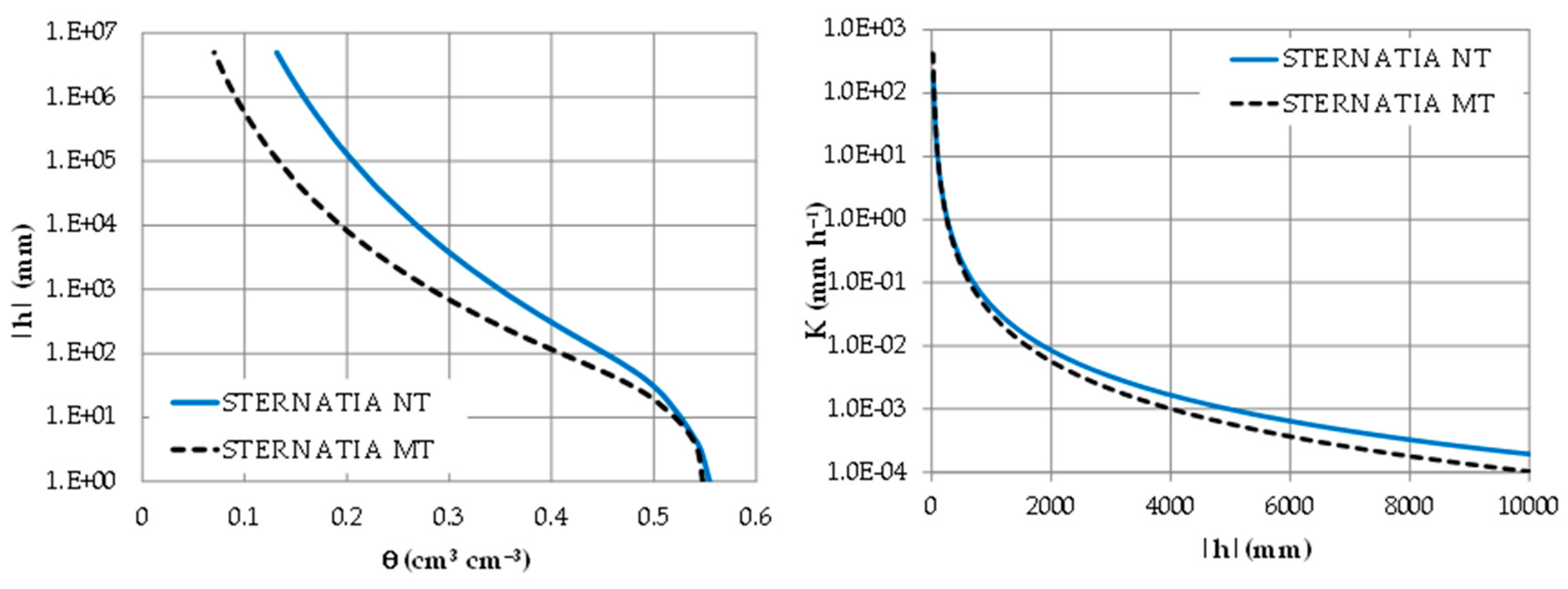
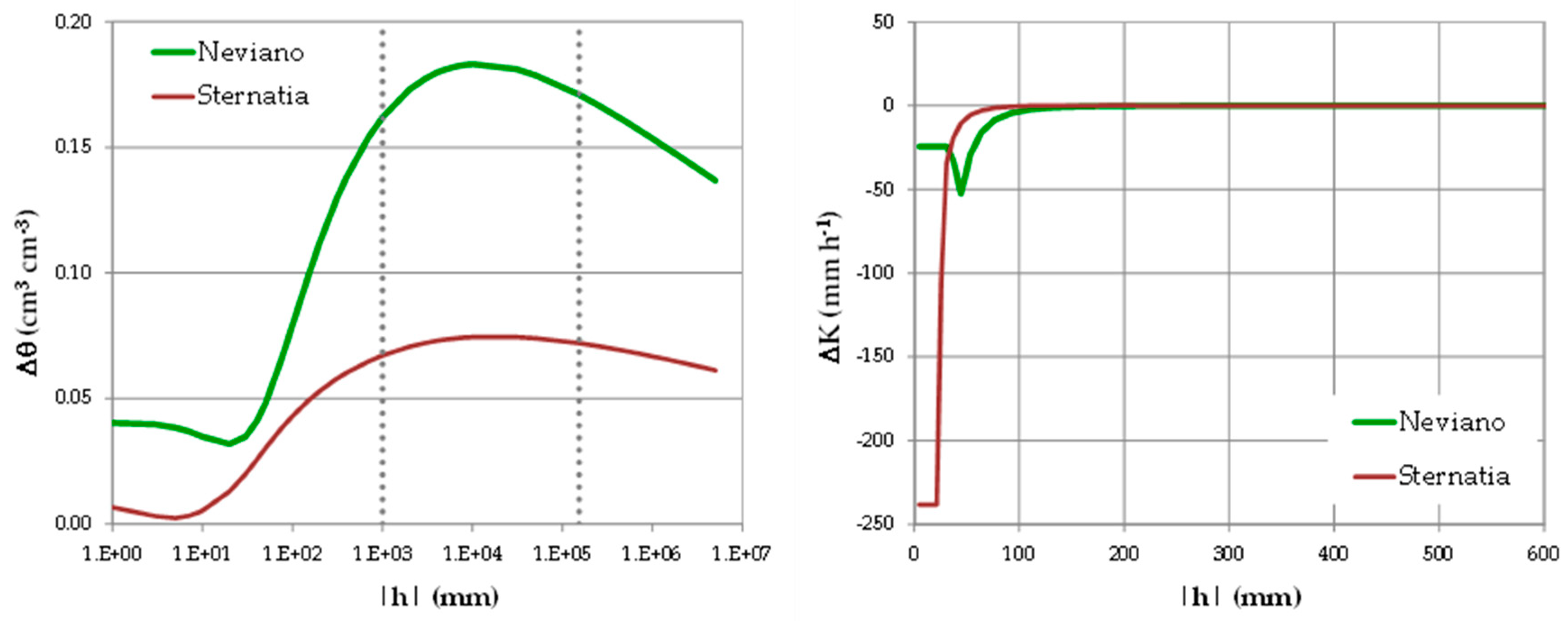
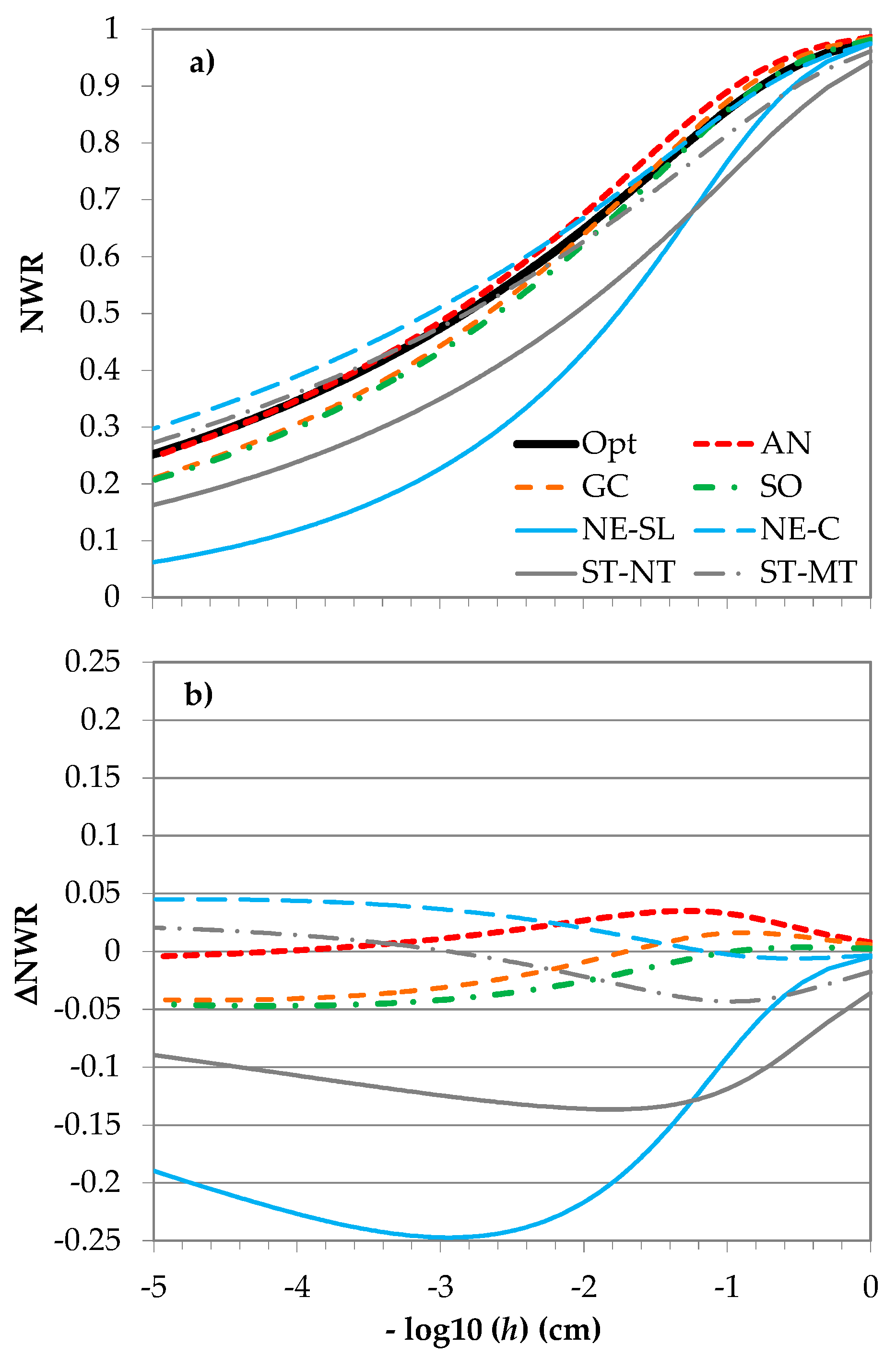
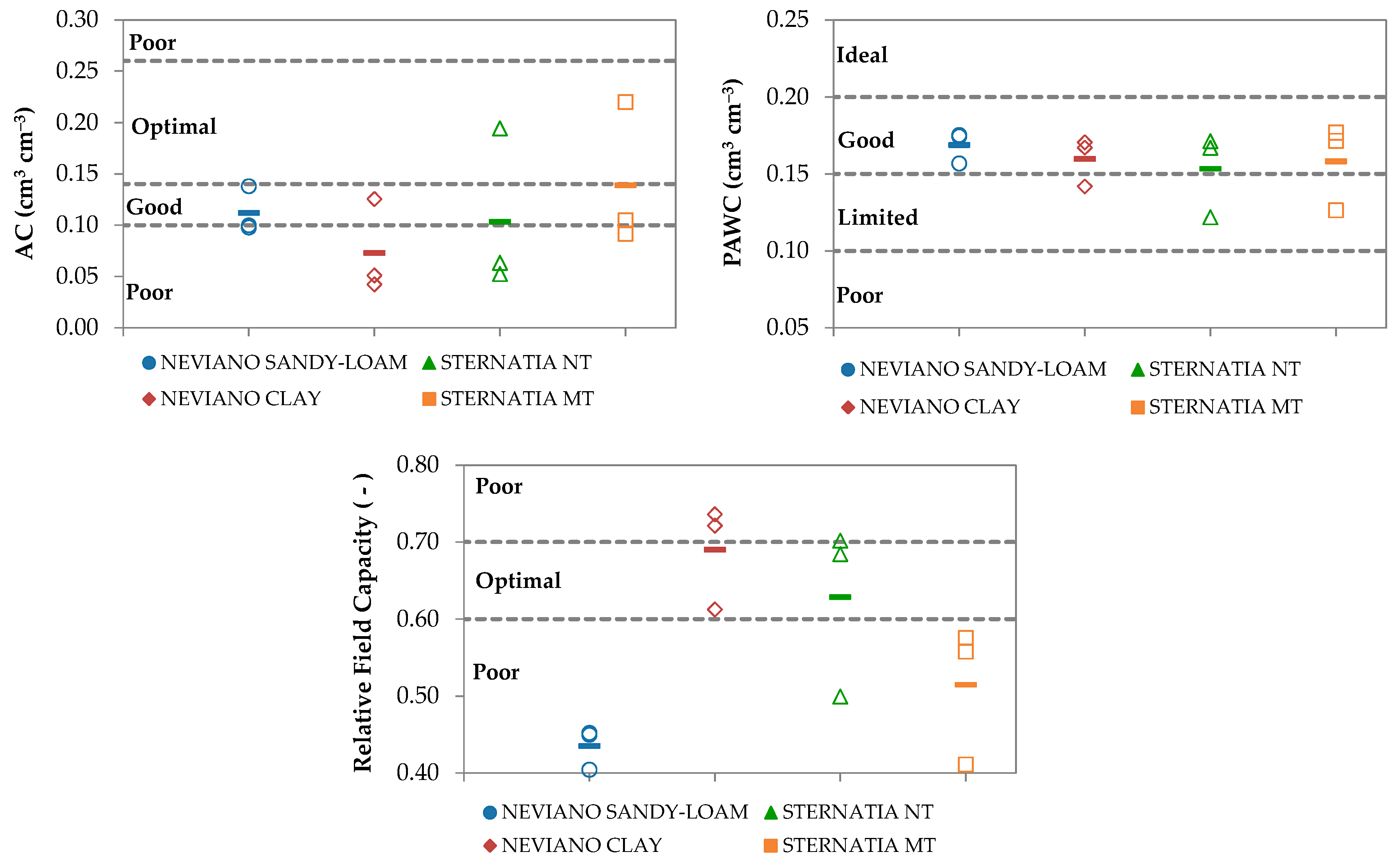
| Site | Acronym | Clay (%) | Silt (%) | Sand (%) | Texture Classification (USDA) | Soil Management | TOC (g kg−1) |
|---|---|---|---|---|---|---|---|
| Andrano | AN | 32.4 | 26.2 | 41.3 | Clay-Loam | NT | 12.4 |
| Gagliano del Capo | GC | 28.2 | 18.1 | 53.7 | Sandy-Clay-Loam | NT | 14.7 |
| Soleto | SO | 29.1 | 13.2 | 57.7 | Sandy-Clay-Loam | NT | 14.8 |
| Neviano | NE-SL | 9.9 | 21.3 | 68.9 | Sandy-Loam | NT | 10.1 |
| NE-C | 46.7 | 16.3 | 37.0 | Clay | NT | 9.9 | |
| Sternatia | ST-MT | 26.8 | 16.9 | 56.2 | Sandy-Clay-Loam | MT | 14.7 |
| ST-NT | 40.2 | 16.8 | 43.0 | Clay | NT | 11.9 |
| Fine | Medium | Coarse | |
|---|---|---|---|
| Sample size | 12 | 16 | 6 |
| AC (cm3 cm−3) | 0.066 (72.7) | 0.074 (55.5) | 0.112 (20.3) |
| PAWC (cm3 cm−3) | 0.161 (9.5) | 0.160 (7.4) | 0.169 (6.2) |
| RFC (−) | 0.666 (9.6) | 0.603 (9.5) | 0.435 (6.2) |
| BD < 1.2 g cm−3 | 1.2 ≤ BD ≤ 1.4 g cm−3 | BD > 1.4 g cm−3 | |
|---|---|---|---|
| Sample size | 6 | 23 | 5 |
| AC (cm3 cm−3) | 0.121 (57.6) | 0.067 (43.1) | 0.049 (34.7) |
| PAWC (cm3 cm−3) | 0.156 (15.9) | 0.164 (5.5) | 0.157 (5.6) |
| RFC (−) | 0.572 (19.3) | 0.615 (13.7) | 0.635 (5.6) |
| 10 < λc < 42 | 42 ≤ λc ≤ 250 | 250 ≤ λc ≤ 1000 | |
|---|---|---|---|
| Sample size | 4 | 13 | 17 |
| AC (cm3 cm−3) | 0.207 (18.2) | 0.085 (27.8) | 0.049 (36.0) |
| PAWC (cm3 cm−3) | 0.124 (2.9) | 0.159 (6.2) | 0.168 (3.5) |
| RFC (−) | 0.455 (13.0) | 0.581 (12.1) | 0.655 (9.9) |
© 2020 by the authors. Licensee MDPI, Basel, Switzerland. This article is an open access article distributed under the terms and conditions of the Creative Commons Attribution (CC BY) license (http://creativecommons.org/licenses/by/4.0/).
Share and Cite
Castellini, M.; Stellacci, A.M.; Mastrangelo, M.; Caputo, F.; Manici, L.M. Estimating the Soil Hydraulic Functions of Some Olive Orchards: Soil Management Implications for Water Saving in Soils of Salento Peninsula (Southern Italy). Agronomy 2020, 10, 177. https://doi.org/10.3390/agronomy10020177
Castellini M, Stellacci AM, Mastrangelo M, Caputo F, Manici LM. Estimating the Soil Hydraulic Functions of Some Olive Orchards: Soil Management Implications for Water Saving in Soils of Salento Peninsula (Southern Italy). Agronomy. 2020; 10(2):177. https://doi.org/10.3390/agronomy10020177
Chicago/Turabian StyleCastellini, Mirko, Anna Maria Stellacci, Marcello Mastrangelo, Francesco Caputo, and Luisa Maria Manici. 2020. "Estimating the Soil Hydraulic Functions of Some Olive Orchards: Soil Management Implications for Water Saving in Soils of Salento Peninsula (Southern Italy)" Agronomy 10, no. 2: 177. https://doi.org/10.3390/agronomy10020177
APA StyleCastellini, M., Stellacci, A. M., Mastrangelo, M., Caputo, F., & Manici, L. M. (2020). Estimating the Soil Hydraulic Functions of Some Olive Orchards: Soil Management Implications for Water Saving in Soils of Salento Peninsula (Southern Italy). Agronomy, 10(2), 177. https://doi.org/10.3390/agronomy10020177






